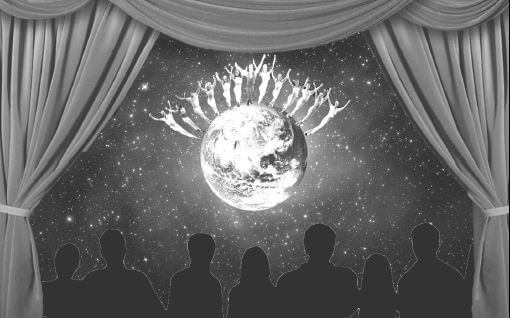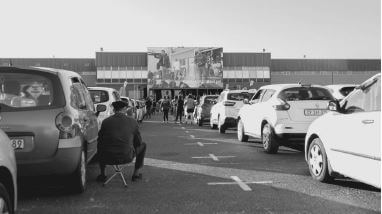DRAMATIC ARTS GRADE 12 QUESTIONS - NSC PAST PAPERS AND MEMOS NOVEMBER 2021
Share via Whatsapp Join our WhatsApp Group Join our Telegram GroupINSTRUCTIONS AND INFORMATION
- This question paper consists of FOUR sections:
SECTION A: 20th Century Theatre Movements (30)
SECTION B: South African Theatre: 1960–1994 (40)
SECTION C: South African Theatre: Post-1994 – Contemporary (40)
SECTION D: The History of Theatre, Practical Concepts, Content and Skills (40) - SECTION A
QUESTION 1 is COMPULSORY.
Refer to the play text you have studied and its relevant 20th Century Theatre Movement.- EPIC THEATRE
- Caucasian Chalk Circle Bertolt Brecht
- Kaukasiese Krytsirkel Translation of Bertolt Brecht play text
- Mother Courage Bertolt Brecht
- Moeder Courage Translation of Bertolt Brecht play text
- The Good Person of Szechwan Bertolt Brecht
- Kanna Hy Kô Hystoe Adam Small
OR
- THEATRE OF THE ABSURD
- Waiting for Godot Samuel Beckett
- Afspraak met Godot Translation of Samuel Beckett play text
- Bagasie André P Brink
- The Bald Primadonna Eugene Ionesco
- Die Kaalkop Primadonna Translation of Eugene Ionesco play text
OR
- POSTMODERN THEATRE
- Skrapnel Willem Anker
- Top Girls Carol Churchill
- Popcorn Ben Elton
- Buried Child Sam Shepard
- EPIC THEATRE
- SECTION B
This section consists of THREE questions. Answer only ONE question in this section.
QUESTION 2: Woza Albert! Percy Mtwa, Mbongeni Ngema and Barney Simon OR
QUESTION 3: Sophiatown Junction Avenue Theatre Company OR
QUESTION 4: Siener in die Suburbs PG du Plessis - SECTION C
This section consists of THREE questions. Answer only ONE question in this section.
QUESTION 5: Nothing but the Truth John Kani OR
QUESTION 6: Groundswell Ian Bruce OR
QUESTION 7: Missing Reza de Wet - SECTION D
This section is COMPULSORY. Answer QUESTIONS 8 and 9.
QUESTIONS
SECTION A: 20th CENTURY THEATRE MOVEMENTS
This question is COMPULSORY.
QUESTION 1
Refer to SOURCE A below and answer the question that follows.
SOURCE A
When we watch a play we watch our own lives. |
Discuss, in an essay, how the characters and themes of the 20th Century Theatre Movement and play text that you studied this year might encourage you to see yourself, others and humanity in a different way.
Write the title of the play text and the 20th Century Movement (Theatre of the Absurd OR Epic Theatre OR Postmodern Theatre) you studied at the beginning of your essay.
TOTAL SECTION A: 30
SECTION B: SOUTH AFRICAN THEATRE: 1960–1994
Answer only ONE question in this section.
QUESTION 2: WOZA ALBERT! BY PERCY MTWA, MBONGENI NGEMA AND BARNEY SIMON
Study SOURCE B below and answer the questions that follow.
SOURCE B
| (Lights up, dim, on Mbongeni as Auntie Dudu, an old woman, wearing a white dustcoat as a shawl. She is searching a garbage bin (upturned box). She eats some food, chases flies, then notices the interviewer. She speaks very shyly.) MBONGENI: Hey? My name is Auntie Dudu. No work my boy, I'm too old. Eh? (Listens.) If Morena comes to South Africa? That would be very good. Because everybody will be happy and there will be lots and lots of parties. And we'll find lots of food there (indicates bin) cabbages, tomatoes, chicken, hot dogs, all the nice things white people eat. (Receives tip.) Oh, thank you, my boy. |
During the Covid-19 pandemic you were asked to teach a lesson to a group of your classmates as revision for the final theory examination.
Use SOURCE B and the following questions to guide the preparation and presentation of your lesson.
2.1 Summarise the plot of Woza Albert! in a paragraph, to remind your classmates what the play is about. (4)
2.2 State why this scene in SOURCE B might have a powerful impact on the audience. (4)
2.3 Suggest to what extent SOURCE B reflects the consequences of the apartheid system. (4)
2.4 Explain to your classmates how Mbongeni might use his vocal or physical skills to transform (change) into the character of Auntie Dudu. (4)
2.5 Motivate how Poor Theatre elements might help the actor to create the character of Auntie Dudu.(4)
2.6 Discuss why it is important for your classmates to have a meaningful debate about the issues raised in the play through the character of Auntie Dudu. (6)
2.7 Analyse how the physical and performance skills you have learnt in Dramatic Arts might assist you in presenting an interesting and effective lesson. (4)
2.8 The final aim of your lesson to your classmates is to reflect on the play Woza Albert!.
Discuss your interpretation of the characters and the themes of the play and how it influences your views of the past, present and future South Africa. (10)
[40]
QUESTION 3: SOPHIATOWN BY THE JUNCTION AVENUE THEATRE COMPANY
Study SOURCE C below and answer the questions that follow.
SOURCE C
| CHARLIE: You're lying to me! You'll never come back. MINGUS: I will. CHARLIE: No you won't. Don't try and stop me. MINGUS: Alright! Now just do yourself a worldly favour … CHARLIE: No, no, no. Don't try and talk to me. You just want to dump me. MINGUS: Will you listen! If you listen I'll explain. CHARLIE: No! MINGUS: (with uncharacteristic compassion.) Charlie, do you know who you are? Have you ever looked at yourself, stared at that face of yours, and asked yourself who you are? Looked in the car mirror and asked, 'Who am I?' You just can't come with me. |
During the Covid-19 pandemic you were asked to teach a lesson to a group of your classmates as revision for the final theory examination.
Use SOURCE C and the following questions to guide your preparation and presentation of your lesson.
3.1 Summarise the plot of Sophiatown in a paragraph, to remind your classmates what the play is about. (4)
3.2 State why the scene in SOURCE C might have a powerful impact on the audience. (4)
3.3 Suggest to what extent SOURCE C reflects the consequences of the apartheid system. (4)
3.4 Explain, to your classmates, how the actor portraying Mingus might use his vocal or physical skills to present the harsh reality that Charlie has to face (SOURCE C). (4)
3.5 Explain how Stanislavski's techniques/methods might help an actor create the character of Mingus in SOURCE C. (4)
3.6 Discuss why it is important for your classmates to have a meaningful debate about the issues that characters such as Mingus and Charlie experience. (6)
3.7 Analyse how the physical and performance skills you have learnt in Dramatic Arts might assist you in presenting an interesting and effective lesson. (4)
3.8 The final aim of your lesson to your classmates is to reflect on the play Sophiatown.
Discuss your interpretation of the characters and the themes of the play and how it influences your views of the past, present and future South Africa. (10)
[40]
QUESTION 4: SIENER IN DIE SUBURBS BY PG DU PLESSIS
Study SOURCE D below and answer the questions that follow.
SOURCE D
| GIEL: Kom gou! Tjokkie sien. Kom, hy begin al. MA: My arme kind. GIEL: Sjuut, hy gaan sien. TJOKKIE: Dit word helder, dit word helder. Ek sien 'n muur. Baksteenmuur. Daar's 'n blomakkertjie. Dis voor Tiemie se venster. Dis die akkertjie. Die grond is mooi bewerk. Niks vuilgoed nie. Daar kom 'n man na die beddinkie toe. Hy buk. Hy plant iets. Dit lyk soos 'n saadjie. Hy gaan weer weg. |
During the Covid-19 pandemic you were asked to teach a lesson to a group of your classmates as revision for the final theory examination.
Use SOURCE D and the following questions to guide your preparation and presentation of your lesson.
4.1 Summarise the plot of Siener in die Suburbs in a paragraph, to remind your classmates what the play is about. (4)
4.2 State why the scene in SOURCE D might have a powerful impact on the audience. (4)
4.3 Suggest how SOURCE D reflects the tragedy of Tjokkie's life. (4)
4.4 Explain, to your classmates, how the actor playing Tjokkie might use his vocal or physical skills in lines 4–7 to show that he is 'seeing' (SOURCE D) (4)
4.5 Explain how Stanislavski's techniques/methods might help an actor create the character of Tjokkie in SOURCE D. (4)
4.6 Discuss why it is important for your classmates to have a meaningful debate about the issues that characters such as Tjokkie experience. (6)
4.7 Analyse how the physical and performance skills you have learnt in Dramatic Arts might assist you in presenting a dynamic and effective lesson. (4)
4.8 The final aim of your lesson to your classmates is to reflect on the play Siener in die Suburbs.
Discuss your interpretation of the characters and the themes of the play and how it influences your views of the past, present and future South Africa. (10)
[40]
TOTAL SECTION B: 40
SECTION C: SOUTH AFRICAN THEATRE: POST-1994 – CONTEMPORARY
Answer only ONE question in this section.
QUESTION 5: NOTHING BUT THE TRUTH BY JOHN KANI
Study SOURCE E below and answer the questions that follow.
SOURCE E
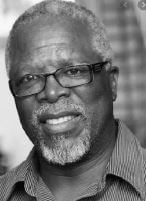 |
| Adapted interview with John Kani, the playwright of Nothing but the Truth. When I wrote this play, I wanted to bring people together. I looked into the themes of reconciliation and forgiveness within a family who live in South Africa. Nothing but the Truth is an example of how people have to forgive themselves for the mistakes they made. But before they can forgive they must come to terms with who they are and why they made those mistakes. This process can be difficult for some people because they still have hatred inside themselves. Only when they have freed themselves from that hatred can they start with the process of forgiveness. I decided to set the play in 2000. It was the beginning of a new millennium and the beginnings of the New South Africa. This was a time of great political and social change, a time of looking back on an apartheid past and facing the truth of that past. A time of taking stock of the realities of the present and a time of finding reconciliation through forgiveness. It was also a time of moving forward into a future filled with freedom and possibilities. It is in this context that the characters find themselves. For instance Sipho lives with a bitterness of what his brother Themba did to him. Themba stole his bus, his blazer and his wife. Out of his personal drama and pain, Sipho undergoes his own personal truth and reconciliation process. He does this by facing the past and forgiving his brother for the betrayal. |
Imagine you are John Kani. You are interviewed by Arts Tonight about your play NOTHING BUT THE TRUTH. Answer the following questions.
| Interviewer: Welcome to Arts Tonight, Mr John Kani. Your play Nothing but the Truth opens next week at the local theatre. |
5.1 What inspired you to write this play? (2)
5.2 Describe the relationship between the characters that appear on stage. (6)
5.3 Inform the viewers why Themba, who does not appear on stage, is such an important character. (4)
5.4 Motivate your choice of the play's setting. (4)
5.5 Clarify for the viewers, how specific events in South Africa's history influenced the plot of the play. (6)
5.6 Explain how the lighting, sound, costume and set design could enhance (add to) the realism of the play. (8)
5.7 Tell the people at home why it is important for the youth in South Africa to watch this play. (10)
[40]
QUESTION 6: GROUNDSWELL BY IAN BRUCE
Study SOURCE F below and answer the questions that follow.
SOURCE F
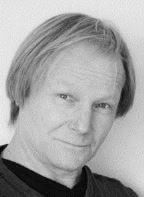 | Adapted interview with Ian Bruce, the playwright of Groundswell. |
| On the barren diamond-diving coast of South Africa, Johan and Thami, an ex-cop and a gardener from contrasting backgrounds, manage a beachfront guest lodge while looking for a way to escape their dead-end lives. When Smith, a retired businessman, shows up one foggy night, the two men think they've found an ideal investor for their scheme to buy into a government-run diamond mining concession. Soon, these rootless men find themselves in a power struggle fuelled by greed, desperation and entitlement. | |
Imagine you are Ian Bruce. You are interviewed by Arts Tonight about your play GROUNDSWELL. Answer the following questions.
| Interviewer: Welcome to Arts Tonight, Mr Ian Bruce. Your play Groundswell opens next week at the local theatre. |
6.1 What inspired you to write this play? (4)
6.2 Describe the relationship between the characters that appear on stage. (6)
6.3 Inform the viewers why Thami's wife, who does not appear on stage, is such an important character in the play. (4)
6.4 Motivate your choice of the play's setting. (4)
6.5 Clarify for the viewers, how specific events in South Africa's history influenced the plot of the play. (4)
6.6 Explain how the lighting, sound, costume and set design could enhance (add to) the realism of the play. (8)
6.7 Tell the people at home why it is important for the youth in South Africa to watch this play. (10)
[40]
QUESTION 7: MISSING BY REZA DE WET
Study SOURCE G below and answer the questions that follow.
SOURCE G
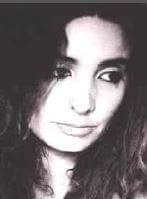 | I wanted to give an insight into South African society in the 1930s. The genre of the play is both magic and mystery. In Missing, I explore the dark nuances of Calvinism and the effect that these have on this group of people. An example is of Miem, who would traditionally be a house-wife, and Gabriel, her husband, who would be 'the man of the house'. However, through a set of circumstances, Miem finds herself taking Gabriel's male role while he withdraws into the loft. The main plot is about a mother (Miem) who keeps her daughter (Meisie) under strict supervision at their poor, remote farm during the Depression. They earn a living sewing sacks for the mountains of manure brought to them by surrounding farmers. The night action that takes place is a strange one: haunting music fills the air from the nearby circus. Miem forbids Meisie to visit the circus. |
| A mysterious blind policeman visits the mother and her daughter. This night is the anniversary of many mysterious disappearances of young women from their homes. It is expected that the killer, or abductor, of these girls will strike again. Sound effects play a large role in the play. The performance is lined with haunting circus music, played each time the door opens. This is a reminder of the 'danger' that lies outside. It also communicates the mysterious and magical. | |
Imagine you are Reza de Wet. You are interviewed by Arts Tonight about your play MISSING. Answer the following questions.
| Interviewer: Welcome to Arts Tonight, Ms Reza de Wet. Your play Missing opens next week at the local theatre. |
7.1 What inspired you to write this play? (4)
7.2 Describe the relationship between the characters that appear on stage. (6)
7.3 Inform the viewers why Gabriel, who does not appear on stage, is an important character. (4)
7.4 Motivate your choice of the play's setting. (4)
7.5 Clarify for the viewers, how specific events in South Africa's history influenced the plot of the play. (4)
7.6 Explain how the lighting, sound, costume and set design could enhance (add to) the realism of the play. (8)
7.7 Tell the people at home why it is important for the youth in South Africa to watch this play. (10)
[40]
TOTAL SECTION C: 40
SECTION D: THE HISTORY OF THEATRE, PRACTICAL CONCEPTS, CONTENT AND SKILLS
QUESTIONS 8 and 9 are COMPULSORY.
QUESTION 8
Study SOURCE H and I below and answer the questions that follow.
SOURCE H
BACKGROUND AND INFORMATION ON WHAT A DRIVE-IN THEATRE IS A drive-in theatre is similar to a drive-in cinema. It has a large car park with marked out spaces for each car. Cars would park in rows next to one another. At the back of the car park would be a building with a film projector. From this projector room the movie is projected onto a large white screen. This screen is in front of the parked cars. Next to each car would be a speaker which the passengers of the car would turn on to listen to the sound of the movie. |
SOURCE I
THEATRE IS ON THE MOVE! With the negative impact of the Covid-19 pandemic on the theatre industry, some creative people had to rethink the way we make theatre. [Extract from a blog by Tina Abrahams, November 2020] |
8.1 Motivate why it was important during the Covid-19 pandemic to 'rethink the way we make theatre'. (4)
8.2 Describe how the Southeaster Festival organisers created a new way of producing theatre during the Covid-19 pandemic (SOURCES H and I). (4)
8.3 Evaluate the advantages and disadvantages of staging a live theatre performance in any ONE of the following venues: a drive-in theatre, a soccer stadium or street theatre. (6)
8.4 Discuss the skills and technical requirements actors might need to perform effectively in the space you have chosen in QUESTION 8.3. (6)
8.5 Suggest TWO other ways you could 'rethink the way we make theatre' in the 21st century. (4)
[24]
QUESTION 9
During lockdown it was important for you to prepare for your practical examination (individual theme programme/audition programme) and your written examination.
9.1 Evaluate how links help create connections between three dramatic items (poem, monologue, storytelling, movement, etc.) of an individual theme programme/audition programme. (6)
9.2 Create self-study notes to prepare for your Dramatic Arts theory examination on ONE of the following:
- Poor Theatre
OR - Protest Theatre
OR - Workshop Theatre
(Your notes might take the form of a mind map/spider diagram/summary/bullet points.) (10)
[16]
TOTAL SECTION D: 40
GRAND TOTAL: 150
